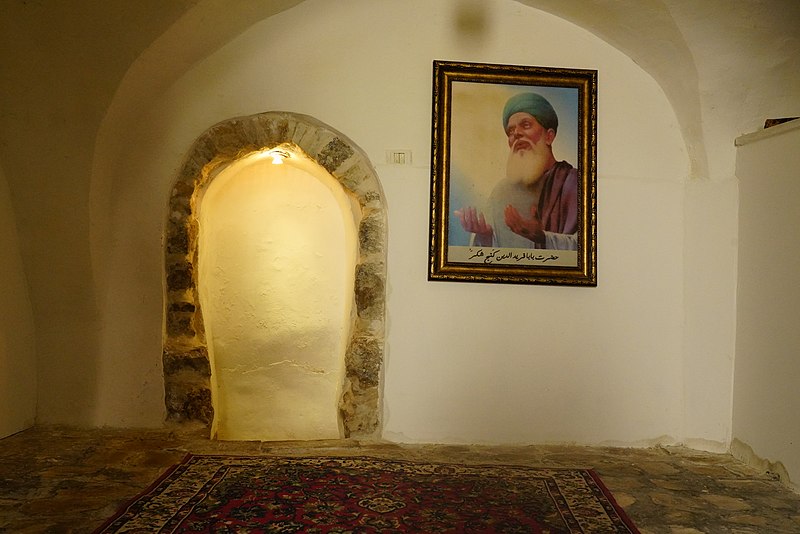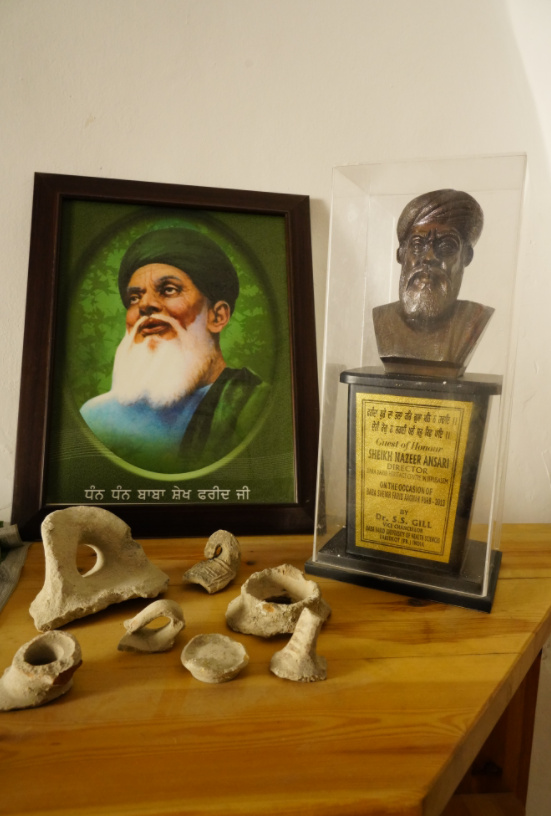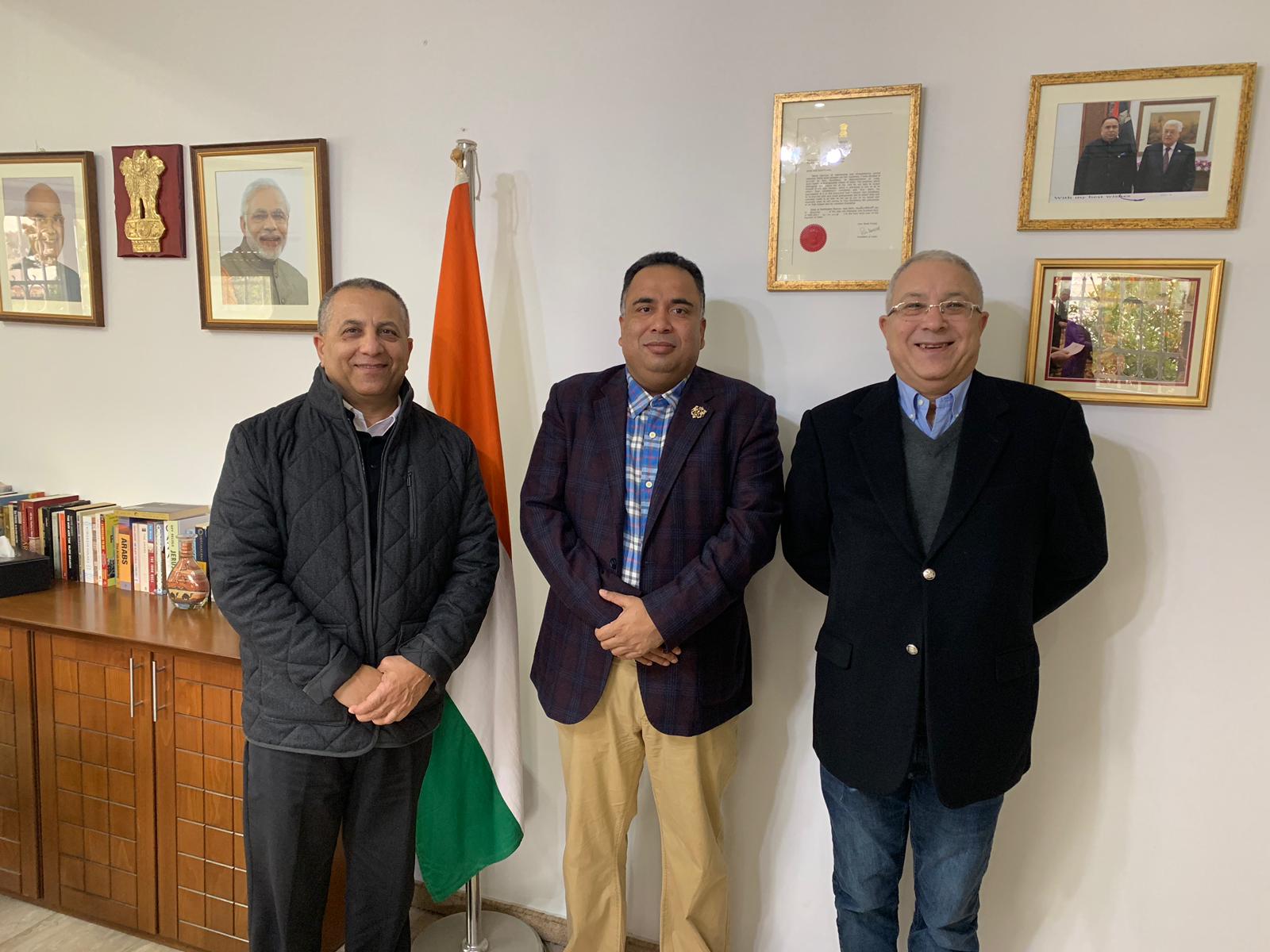Earlier this week, India’s Permanent Representative to the UN Ambassador, TS Tirumurti, issued a statement at the United Nations Security Council meeting articulating New Delhi’s position on the current conflict between Israel and Palestine. In the statement, he issued strong support to the Palestinian cause and the two-State solution, besides condemning all acts of violence. But he also made a brief mention of a structure dating back 800 years in the Old City of Jerusalem, which holds a special place in the hearts of many Indians. Situated opposite the Herod’s Gate in the Old City, the Indian Hospice or ‘Al Zawiyya Al Hindiyya’ is a symbol of India’s heritage and composite culture.
(Image of Sheikh Mohammad Munir Ansari on the left and the Indian Hospice on the right.)
Run by a family which has its roots in Saharanpur, Uttar Pradesh, this quaint and beautiful structure with an Indian flag waving on its rooftop continues to accommodate visitors from their homeland even today despite several moments in its 800-year-old history when its mere existence was in jeopardy.

When an Indian Dervish Walked Into An Ancient City
The Indian Hospice story begins sometime in the early years of the 13th century, when Hazrat Farid ud-Din Ganj Shakar, a member of the Christi order of Sufis—one of the most popular mystic orders of Islam which thrives even today in countries like India, Pakistan and Afghanistan—from Punjab, popularly known as Baba Farid, walked into Jerusalem.
The great Indian Sufi saint, Baba Farid, had entered the city, which is sacred to all three major Abrahamic religions, nearly a decade after Saladin’s armies had driven the Christian Crusaders out of Jerusalem and reclaimed the city for Muslims. There are no definitive accounts of how long Baba Farid lived in the city, but Sufi saints like him were welcomed with open arms.
“No one knows how long Baba Farid stayed in the city. But long after he had returned to Punjab, where he eventually became head of the Chisti order, Indian Muslims passing through Jerusalem on their way to Mecca wanted to pray where he had prayed, to sleep where he had slept. Slowly, a shrine and pilgrim lodge, the Indian Hospice, formed around the memory of Baba Farid,” writes Navtej Sarna, India’s former ambassador to Israel, who published a book called Indians at Herod’s Gate: A Jerusalem Tale.
Future accounts of his life recall how he spent days fasting in a cave inside the Old City’s walls praying and sweeping stone floors around the famous al-Aqsa mosque. Another interesting aspect about Baba Farid’s life is the poems he wrote not in Arabic or Sanskrit, but in his native Punjabi, which his followers sang at the Hospice long after he left. These poems not only laid the foundations of Punjabi literature as centuries went by but also brought together the Sufi and Sikh traditions. After all, his hymns had found their way into the Guru Granth Sahib, the central religious scripture of Sikhism.

“They say Baba Farid came here from India, meditated here, and then his followers began to come and stay here. A long time ago. They were given a waqf [property given in the name of God for religious and charitable purposes], first the mosque and those two rooms. And then the property expanded through the centuries as a place for Indian pilgrims to stay,” said Sheikh Mohammad Munir Ansari, director of the Hospice, according to Sarna’s book.
Rise and Decline
For the next four centuries, a myriad of Sufi groups from across the Islamic world came to Jerusalem joining the Indians who had arrived in the 13th century. These groups brought with them funds that built lodges and schools for mystics from North Africa, Central Asia and Eastern Europe. These lodges were fully functional until World War I, with the Ottoman Empire playing an important role in sheltering them from any harm.
However, once the Great War began in 1914, traditional pilgrimage and trade caravan routes that practitioners of Sufism would employ began closing down. Post World War I, the victorious European nations drew their artificial national borders across the Middle East, distributing land among themselves. With changing geopolitical realities and the growing appeal of a more conservative form of Islam, Sufism began to fade away in the region.
As a result, these Sufi lodges began closing down their gates. Many of these structures fell into a state of disrepair and decrepitude. When the Ottoman Empire finally came crashing down in 1922, there was little hope that structures like the Indian Hospice would survive. Out of sheer desperation, resentment of British colonial rule and influx of European Jews, the Islamic authorities in Jerusalem began seeking friends and allies.
“In 1923, Jerusalem’s Grand Mufti, Haj Amin al-Husseini (whose search for support would eventually lead him into a murderous collaboration with both Hitler and Mussolini), sent a delegation to India seeking funds for the restoration of al-Aqsa mosque. There, they met the leaders of the Khilafat movement — Indian Muslims who were agitating against British rule and struggling to promote the idea of a pan-Islamic Caliphate. The Palestinians told their Indian hosts about the decaying lodge. Could they send somebody — an Indian Muslim — to take charge?,” writes Sarna, the former Indian Ambassador to Israel, for the BBC.
The man chosen for the task was Nazir Hasan Ansari from Saharanpur, who arrived in Jerusalem in 1927, more than 700 years after Baba Farid first came. For the next 27 years, Sheikh (Master of the Hospice in this context) Nazir played a pivotal role in restoring and reviving the Indian Hospice while reclaiming the idea of Jerusalem becoming a holy city for Indian Muslims. When Indian pilgrims started making their way to Jerusalem again, the Hospice came back to life. Through the 1920s and ’30s, Sheikh Nazir collected funds from different Muslim princes in India to pay for the rebuilding of the lodge.

In 1928, he married a Palestinian woman called Mussarra, who gave birth to his son Mohammed Munir Ansari.
The years before World War II were particularly great for the Hospice. The Indian Hospice was like a ‘Little India’ inside Jerusalem. Upon entering the gate, there were multiple accounts of how one would smell Indian food brought by pilgrims travelling by ship from India.
Once again, World War I stopped the flow of pilgrims inside Jerusalem. The Hospice was soon converted into a leave camp for the Indian Fourth Infantry division. Instead of pilgrims, now you had soldiers who only left once the first Arab-Israeli War broke out in 1948.
By some accounts, there were over 150 Indian soldiers of different faiths (Hindu, Muslim, Christian and Sikh) stationed there. When these soldiers eventually left, they had set up the Travancore Wing and Delhi Manzil inside the Hospice.
When the Arab-Israeli War broke out in 1948 and left behind a sea of Arab refugees, the International Red Cross rented the Delhi Manzil to feed them. Today, the United Nations Relief and Works Agency (UNRWA)’s office and clinic run from that section.
When Munir succeeded his father in 1952 to take charge of the Hospice, it was badly damaged by all the shelling and filled to the brim with Palesntinian refugees. Things only got worse during the Six Day War of 1967 between Israel on one side and Jordan, Syria, and Egypt on the other. The Hospice was heavily bombarded by Israeli forces.
Sheikh Munir desperately sought cover. But the shells eventually landed near the shrine of Baba Farid, killing his mother, sister and two-year-old nephew. Meanwhile, Munir’s face and hands suffered serious burns as he pulled out survivors from the rubble.
“From 1967 to 1991 this place was frozen,” said Munir in a conversation with ISRAEL21c, a non-profit which publishes English news online, in December 2018. “When diplomatic relations were established between Israel and India, we reconnected with the Foreign Ministry in India and started rebuilding and renovating.”

In Sarna’s book, Munir addresses the loss of freedom in Occupied East Jerusalem after the 1967 war, saying, “If you are not free, you are dead. One does not live on this food alone.”
But despondency was not an option for Munir. His own grief was eased by the joy of raising his five children in the Indian Hospice and slowly rebuilding the rooms destroyed by shells.
Today, the lodge has a library, mosque and guest rooms for Indians who still visit, while the tricolour continues to wave proudly on the rooftop even though the city itself simmers with tension and spurts of violence. For his exceptional service to the Hospice, President Pratibha Patil awarded Sheikh Munir the Pravasi Bharatiya Samman in 2011.
In 2019, Palestinian President Mahmoud Abbas conferred Munir with the Star of Jerusalem medal, which ranks among the highest honours given to foreign nationals by the Palestinian Authority. After Munir, his elder son Nazer is expected to take charge of the Hospice. Hopefully, this legacy stays intact for future visitors.

(Edited by Yoshita Rao)
No comments:
Post a Comment